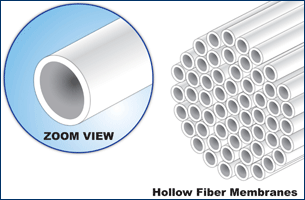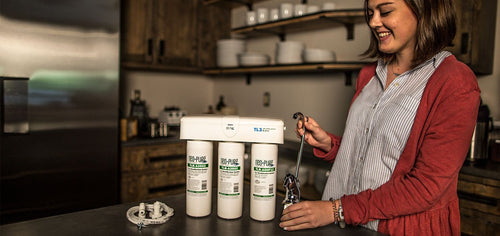Ultrafiltration (UF) uses standard home water pressure to push water through a semipermeable membrane and remove any contaminants. Unlike reverse osmosis, ultrafiltration retains minerals in the water, while filtering out bacteria, viruses, and parasites.
How ultrafiltration works
Ultrafiltration is one membrane filtration process that serves as a barrier to separate harmful bacteria, viruses, and other contaminants from clean water. An ultrafiltration water system forces water through a .02 micron membrane. Suspended particles that are too large to pass through the membrane stick to the outer membrane surface. Only fresh water and dissolved minerals pass through.

Reverse osmosis vs ultrafiltration
Many ultrafiltration systems use a hollow fiber membrane, which filters water from the inside out. This provides a large surface area for particles to adhere to. Other membranes, like the spiral wound RO membrane, filter from the outside in. The hollow fiber membrane has a high chemical resistance to oxidants and chlorine, but a TFC reverse osmosis membrane cannot tolerate any chlorine.
A reverse osmosis system provides the most extensive filtration because the RO membrane has the smallest pore size, but this level of filtration is not always necessary or preferred. A UF system retains beneficial minerals that an RO system removes. However, this means that an ultrafiltration system does not remove salts, fluoride, or TDS dissolved in water. An ultrafiltration system also operates on low water pressure, but a reverse osmosis system needs a booster pump to increase water flow.
Ultrafiltration vs nanofiltration and microfiltration
The difference between all four types of membrane filtration-- reverse osmosis, nanofiltration, ultrafiltration, and microfiltration-- is the membrane pore size or reduced particle size. The method you need depends on the level of water quality you want or need. The chart below shows the spectrum of reduction for each type of membrane filtration.

When is ultrafiltration used?
The distinction in pore size and types of particles removed means each type of filtration serves a unique purpose.
Ultrafiltration is the filtration method of choice for people who prefer minerals left in their water but still want microscopic contaminants taken out. A UF system may be selected over an RO system because it wastes less water to the drain. Someone may choose UF in California where water use is regulated. Someone in South Carolina, where the water has few dissolved minerals to begin with, may choose UF since RO wouldn't be necessary. Sometimes, ultrafiltration is used to recycle effluent water after filtration, so the water can be reused for irrigation.
Reverse osmosis is used in situations where all particles including dissolved substance must be stripped from the water. Some people prefer RO water from their refrigerator or tap, especially if they're on well water supply. RO is also favored for saltwater aquariums, where an exact amount of salt can be added back to the clear water. Nanofiltration is frequently used to remove heavy solids in dairy and for some softening purposes. Microfiltration removes suspended solids like algae and sediment.
What can ultrafiltration remove?
The UF membrane is a super fine filter that reduces particles 5,000 times smaller than a human hair. Ultrafiltration gives 90-100% reduction in these contaminants. While UF can't reduce some organics, a .05 micron carbon block prefilter can be added to a system to reduce chlorine taste and odor, lead, cysts, volatile organic compounds (VOCs), and metallic trace elements (MTE). A UF membrane lasts about two years.

Ultrafiltration benefits
- System operates at a low pressure
- Removes bacteria and viruses
- Keeps essential minerals in water
- Installs quickly and easily
- Does not generate waste water
An ultrafiltration system is eco-friendly. Ultrafiltration has a 90-95% recovery rate and can be used to treat wastewater for reuse. Using a home ultrafiltration water system benefits the environment by reducing the amount of plastic water bottles discarded in landfills.
Ultrafiltration for drinking water
In the past, ultrafiltration was reserved for hospitals and large city water plants. Now, ultrafiltration is offered as an under sink water filter. UF drinking water systems can provide your family with great-tasting water on the go. Using a BPA-free Neo-Vas stainless steel water bottle will prevent any harmful chemicals from leaching into your drinking water.
We developed the Neo-Pure TL3 ultrafiltration system with a more efficient carbon filter and twist-lock cartridges for easy replacements. The system includes a built-in shutoff valve, so you don't have to shut your water off before changing the filters.
Installing a UF system is simple with 1/4" quick-connect fittings. Each system is supplied with a feed supply adapter to hook up to your cold-water supply with the polyethylene tubing provided with the system. Our ultrafiltration systems also come with a chrome designer faucet.

